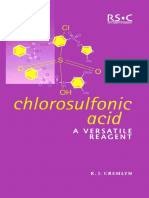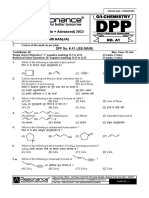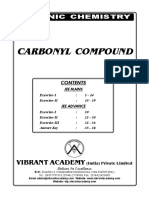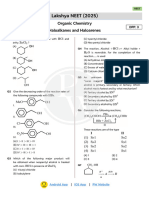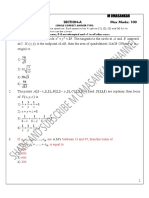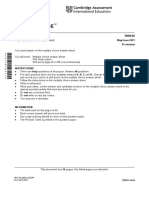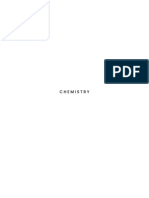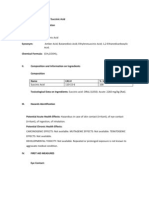Alkyl Halide AT DPP
Alkyl Halide AT DPP
Uploaded by
Kalyan ReddtCopyright:
Available Formats
Alkyl Halide AT DPP
Alkyl Halide AT DPP
Uploaded by
Kalyan ReddtOriginal Title
Copyright
Available Formats
Share this document
Did you find this document useful?
Is this content inappropriate?
Copyright:
Available Formats
Alkyl Halide AT DPP
Alkyl Halide AT DPP
Uploaded by
Kalyan ReddtCopyright:
Available Formats
CHEMISTRY ALKYL HALIDE
EE
TJ
: A
d
Alkyl e Halide
C o
Ashwani Tyagi Sir (Code: ATJEE)
Chemistry
ASHWANI TYAGI SIR 1 CODE: ATJEE
CHEMISTRY ALKYL HALIDE
PRACTICE DPP # 1
Q.6 W hich reaction is termed as Darzen’s
Questions Methods of preparation of
based on alkyl halide Reaction -
(A) ROH + HCl (B) ROH + PCl5
(C) ROH + SOCl 2 (D) ROH + PCl3
Q.1 The formation of an alkyl halide by reaction
of hydrogen halide on an unsymmetrical Q.7 The reaction of silver carboxylates with
alkene is an example of - bromine dissolved in carbon tetrachloride is
called -
(A) A nucleophilic addition reaction
(A) Hofmann reaction
(B) An electrophilic addition reaction
(B) Borodine reaction
(C) A free radical reaction (C) Borodine - Hunsdiecker reaction
(D) An elimination reaction (D) Hypobromide reaction
Q.2 When propylene reacts with HBr in presence Q.8 In the Hunsdiecker reaction -
of peroxide, the product formed is - (A) Number of carbon atoms decrease
(A) n-Propyl alcohol (B) Number of carbon atoms increase
(B) Propylene peroxide (C) Number of carbon atoms remain same
(C) n-Propyl bromide
EE (D) None of the above
J
(D) 1,3 Dibromo propene
T
Q.9 Silver benzoate reacts with bromine in
acetone to form -
A
Q.3 In reaction
:
C2H5OH + HX ZnX 2
C2H5X + H2O
(A) (B)
the order of reactivity of HX is -
(A) HBr > HI > HCl
(B) HI > HCl > HBr
d e
(C) HCl > HBr > HI
(D) HI > HBr > HCl
C o Q.10
(C) (D)
In Finkelstein Reaction, which reactants are
used -
Q.4 Which of the following leads to the formation
(A) NaI + C2H5OH
of an alkyl halide -
(B) NaCl + acetone
(A) C2H5OH Re d P Br2
(C) NaBr + CH3COCH3
(B) C2H5OH SOCl
2
(D) NaI + CH3COCH3
(C) C2H5OH KBr Conc, H2SO 4
Q.11 C2H5Cl + AgF C2H5F + AgCl
(D) All The above reaction is called -
(A) Hunsdiecker (B) Swart
Q.5 Which halide/ halides not prepared by Darzen
(C) Strecker (D) Wurtz
reaction -
(A) R- Cl (B) RBr
(C) R I (D) (B) & (C) both
ASHWANI TYAGI SIR 2 CODE: ATJEE
CHEMISTRY ALKYL HALIDE
Questions Q.18 In SN1 reaction, the first step involves the
based on
Physical properties
formation of : -
Q.12 Which of the following statement is correct - (A) Free radical (B) Carbanion
(A) Decreasing order of density of alkyl
(C) Carbocation (D) Final product
halides is RI > RBr > RCI > RF
(B) The stability order of alkyl halides is
RF > RCl > RBr >RI Q.19 The rate law for the reaction, RCl + Na (aq.)
(C) Among isomeric alkyl halides the ROH + NaCl is given by, rate = K1 [RCl].
decrease in boiling point 1º > 2º > 3º The rate of the reaction will be : -
(D) All are correct (A) Doubled on doubling the concentration of
sodium hydroxide
Q.13 Which statement is not correct -
(A) Polyhalides are lighter than water (B) Halved on reducing the concentration of
alkyl halide to half
(B) Halo alkanes have higher boiling points
as compared to those of corresponding (C) Decreased on increasing the temperature
alkanes of the reaction
(C) Halides are soluble in organic solvents (D) Unaffected by increasing the temperature
(D) None of the reaction
E
Q.14 An alkyl halide is insoluble in water because-
Q.20 Chlorobenzene is -
E
(A) Alkyl halide is non polar & H2O is polar
J
(A) More reactive than ethyl bromide
(B) Both are polar
T
(B) More reactive than isopropyl chloride
(C) Alkyl halide does not form hydrogen bond
A
with water (C) As reactive as methyl chloride
(D) Alkyl halide has halogen atom in it. (D) Less reactive than benzyl chloride
Q.15
e :
The correct order of polarity of alkyl halides
is : -
Q.21 Which of the following statements is invalid-
(A) The more stable the carbocation the faster
(A) RI > RBr < RCl > RF
(B) RF > RCl > RBr > RI
o d it is formed
(B) Propyl cation changes to more stable
C
isopropyl carbocation by 1,2 shift of a
(C) RCl > RF > RBr > RI hydrogen
(D) None (C) Isopropyl chloride reacts with sodium
ethoxide to form 1-ethoxypropane
Q.16 Which chloride is the most reactive towards (D) n – propyl halides reacts with sodium
aqueous NaOH in - ethoxide to from 2-ethoxypropane
(A) Methyl chloride (B) Chlorobenzene
(C) Vinyl chloride (D) Benzyl chloride Q.22 Vinylic halides are unreactive towards
nucleophilic substitution because of the
Q.17 The SN2 reactivity order for halides :-
following except -
(A) R - F > R - Cl > R - Br > R - I (A) C - halogen bond is strong
(B) R - I > R - Br > R - Cl > R - F (B) The halogen is bonded to sp2 carbon
(C) R - Br > R - l > R - Cl > R - F (C) A double bond character is developed in
(D) R - Cl > R - Br > R - F > R - I the carbon-halogen bond by reasonance
(D) Halide ions are not good leaving groups
ASHWANI TYAGI SIR 3 CODE: ATJEE
CHEMISTRY ALKYL HALIDE
Q.23 Which of the following reaction is the most Q.28 (A) Cl aq. KOH
2
(B) (C)
common among alkyl halides -
(A) Nucleophilic addition (O)
CH3CHO, Identify A, B & C -
(B) Nucleophilic substitution
(A) Ethylalcohol Ethyl chloride & Ethane
(C) Electrophilic addition
(B) Ethane, Ethylchloride & CH3 - CH2 - OH
(D) Electrophilic substitution
(C) Propane, Propylchloride &
CH3 - CH2 - CH2 - OH
Questions Chemical reaction of mono
based on haloalkane (D) All the above
Q.24 When an alkyl halide reacts with an alkoxide, Q.29 An alkyl halide reacted with a metal
the product is - cyanide to give an alkanenitrile. The metal
(A) Ether (B) Ester cyanide is -
(C) Hydrocarbon (D) Alcohol (A) AgCN (B) KCN
(C) Cu2(CN)2 (D) Ba(CN)2
SN1, C H ONa
2 5
Q.25 Ether
williamson Q.30 Ethylthioalcohol can be obtained when
C2H5Br reacts with -
Ether is - (A) KSH (B) NaOH
(C) K2S (D) Na2S
(A)
EE Q.31 Which one of the following reaction is known
J
as strecker;s reaction -
T
(B) (A) R - X + NaI R - I + NaX
(B) R - X + Na2SO3 R - SO3Na + NaX
(C) Both correct
(D) None is correct
: A (C) RCOOAg + Br2 R - Br + AgBr + CO2
(D) None of the above
Q.26
e
2-Bromobutane on heating with alcoholic
alkali forms -
d
Q.32 The reaction
C2H5ONa + BrC2H5 C2H5–O–C2H5 + NaBr
o
is called -
(A) - Butylene only
C
(B) - Butylene only (A) Frankland reaction
(C) 20% of -Butylene+ 80% of -Butylene (B) Wurtz reaction
(D) 80% -Butylene + 20% -Butylene (C) Williamson’s synthesis
(D) Cannizzaro reaction
Q.27 An organic compound on treatment with
alcoholic KOH gives a hydrocarbon of a Q.33 Reaction of ethyl chloride with sodium leads
molecular fromula C4H8. Oxidation of the
to -
hydrocarbon gives propionic acid and CO2.
The organic compound should be - (A) Ethane (B) Propane
(C) n-Butane (D) n-pentane
(A) C2H5 - CH2 - CH2Cl
(B)
Q.34 An alkyl halide reacts with metallic sodium
in dry ether, the reaction is known as -
(C) (A) Frankland’s reaction
(B) Sandmeyer’s reaction
(C) Wurtz’s reaction
(D) CH3 – CH – CH – CH2Cl
(D) Kolbe’s reaction
Cl
ASHWANI TYAGI SIR 4 CODE: ATJEE
CHEMISTRY ALKYL HALIDE
Q.35 When ethyl bromide is treated with moist Questions
based on
Trihalide
Ag2O the product is –
(A) Ethyl ether (B) Ethanol
Q.42 Nitrochloroform (chloropicrin) is used as -
(C) Ethoxy ethane (D) All of the above
(A) An anaesthetic
Questions Dihalide (B) Insecticide
based on
(C) Antiseptic
Q.36 The general molecular f ormula of (D) Insecticide and war gas
dihaloalkanes is -
(A) CnH2n+1X (B) CnH2n+2X2 Q.43 CHCl3 is kept in brown bottles well stoppered
and also with 1% alcohol so that it may not
(C) CnH2nX2 (D) cnH2n-2X2 form -
(A) CH2Cl 2 (B) COCl2
Q.37 A vicinal dihalide is not formed in the reaction-
(C) CCl4 (D) None of these
(A) HOCH2 - CH2OH PBr3
Q.44 Chloroform can be obtained from -
(B) CH3 - CH = CH2 Br
2
(A) Methanol (B) Methanal
(C) CH CH HBr
HBr
(C) Propanol - 1 (D) Propanol - 2
HBr
(D) CH3 - CH = CHBr
Peroxide
I2
E
Q.45 (A) Ag powder
Na2 CO 3
Q.38
except -
E
A gem dichloride is formed in the reaction
J (B) H
2 SO 4
(C).
T
Hg
(A) CH3CHO and PCl5
A
Product A, B & C are -
(B) CH3COCH3 and PCl 5
(A) Iodoform, Acetylene & Acetaldehyde
:
(C) CH2 = CH2 and Cl2 (B) Tri. iodomethane, Ethyne & Acetone
(D) CH2 = CHCl and HCl (C) Iodoform, Ethene & Ethylene glycol
Q.39
d e
2,2– dichloropropane on hydrolysis yields -
(D) Ethene, iodoform & Ethylhydrogen
sulphate
Q.40
(A) Acetone
(C) Isopropyl alcohol
C o
(B) 2,2- Propane diol
(D) Acetaldehyde
Propylidene chloride when heated with zinc
Q.46 Which of the following statement is wrong -
(A) All carbonyl compounds of the general
structure give a positive
gives -
(A) Ethene (B) Propene iodoform test
(C) 1-Butene (D) 3-Hexene (B) All secondary alcohols give iodoform
reaction
(C) Alkanols of the structure CH3CH(OH) - R
Q.41 Ethylene amine is the substitution product (where R = H, alkyl or aryl) give iodoform
of – reaction.
(A) Ethylene chloride (D) The only aldehyde giving iodoform
(B) Gem dihalide reaction is acetaldehyde.
(C) Both of these
Q.47 The oxidation of CHCl3 by air & light is
(D) None of these
prevented by adding -
(A) CH3COOH (B) C2H5OH
(C) CH3CHO (D) CH3COOCH3
ASHWANI TYAGI SIR 5 CODE: ATJEE
CHEMISTRY ALKYL HALIDE
Q.48 Tear gas is - Questions
based on
Tetra halide
(A) C(NO2)Cl3 (B) COCl2
(C) CH3Cl (D) CH3COCl
Q.54 Main product of which of the following
Q.49 Isocyanide reaction involves the intermediate reactions shows zero dipole moment -
formation of - (A) CH3OH, PCl 5
(A) :CCl 2 (B) CH3+ (B) C2H5OH, OH¯ , Cl2
(C) CH3¯ (D) CCl3 (C) CHCl3, Cl 2, hv
(D) CHI3, Zn, HCl
Q.50 The antiseptic character of iodoform is due
to -
Q.55 What happens when CCl4 is treated with
(A) Its poisonous nature
AgNO3 -
(B) Unpleasent smell
(C) Liberation of iodine (A) A white ppt. of AgCl will be formed
(D) None (B) Nothing will happen
(C) NO2 will be evolved
Q.51 Chloroform when treated with aniline and
alcoholic KOH forms - (D) CCl4 will dissolved in AgNO3
(A) Phenyl cyanide
(B) Phenyl isocyanide Q.56 CCl4 + 4KOH ———— end product of the
(C) Phenyl cyanate reaction is –
(A) K2CO3 (B) CO 2
E
(D) Phenyl isocyanate
(C) C(OH)4 (D) HCOOK
Q.52 Iodoform test is not given by : -
J E
T
Q.57 CS2 + Cl2 ———— Product, Product is –
(A) CH3COCH2COOC2H5 (A) CHCl3 (B) CCl4 (C) SCl2 (D) C2S2
(B) CH3COCH3
(C) CH3CH2COCH3
(D) CH3CH2CHOHCH3
: A Q.58 Main cause of Ozone decay is –
(A) CFC (B) BFC
Q.53
d e
2-methyl butanoic acid is formed by the
(C) LMC (D) DKP
o
reaction CHCl3 , NaOH and – Q.59 Which of the following compounds is used
C
(A) Propene (B) Ethene as a refrigerant -
(C) Methane (D) 2-Butene (A) Acetone (B) CCl4
(C) CF 4 (D) CCl2F 2
Q.60 Catalyst used in the f ormation of
dicholorodifluoromethane is generated from -
(A) AlCl3 + HF (B) SbCl5 + HF
(C) SbCl4 + HF (D) BF3 + HF
ASHWANI TYAGI SIR 6 CODE: ATJEE
CHEMISTRY ALKYL HALIDE
PRACTICE DPP # 2
KCN
Q.7 Of the following, which is an SN1 reaction -
Q.1 CH3CHI2
H
2 O,
? Here the (A) (CH3)3CBr + H2O –––––
end product would be - (B) CH3CH2CH2Cl + I – –––––
(A) 2 - Cyano propionic acid (C) (CH3)3CBr + CN– –––––
(B) Ethane - 1,1- dicarboxylic acid (D) CH3CHBrCH3 + OH(alc.) –––––
(C) 2-Methyl ethanoic acid
(D) Propionic acid Q.8 In the reaction,
C2H5OH + HX ZnX
2
C2H5X
Q.2 Industrial preparation of chloroform employs the order of reactivity of HX is -
acetone and - (A) HBr > HI > HCl (B) HI > HBr > HCl
(A) Phosgene (C) HI > HCI > HBr (D) HCl > HBr > Hl
(B) Calcium hypochlorite
KCN 4H
(C) Chlorine gas Q.9 CH3Br
A
CH CH NH
3 2 2
(D) Sodium chloride
IUPAC name of A is -
(A) Methyl cyanide (B) Mehyl isonitrile
Q.3 The elimination of HX from an alkyl halide (C) Acetonitrile (D) Ethane nitrile
forms an alkene. The order of the elimination
reaction is -
EE Q.10 An alkyl halide can not be converted into an
J
(A) 3º halide > 2º halides > 1º halides alcohol by -
(B) 1º halide > 2º halides >3º halides (A) Substitution
(C) 1º halide = 2º halides > 3º halides
A
(D) 2º halide > 1º halides > 3º halidesT (B) Addition
(C) Elimination
:
(D) Dehydrohalogenation
e
Q.4 A O Br
CHBr3 Q.11 Function of bleaching powder in the formation
d
Here A is nothing but - of trichloro-methane from ethyl alcohol is -
(A) To provide nascent Cl for oxidation
o
(A) Isopropyl alcohol (B) Methanol
(C) Ethanoic acid (D) n- Butyl alcohol (B) To carry out chlorination of acetaldehyde
Q.5 C
Which of the following, on being heated with
alcoholic KOH, will respond positively to the
Q.12
(C) To carry out hydrolysis of chloral
(D) To carry out all the three processes
Ethyl bromide can be converted into ethyl
carbylamine test -
alcohol by -
(A) Chloroform and silver powder
(A) Heating with an alcoholic solution of KOH
(B) Chloroform and aniline (B) The action of moist silver oxide
(C) Methyl chloride and aniline (C) Heating with dil. HCl and Zn
(D) Methyl cyanide and aniline (D) Refluxing with methanol
Q.6 Arrange the following compounds according Q.13 Impure chloroform cannot be tested by -
to their relative reactivity with alcoholic AgNO3 - (A) Concentrated sulphuric acid
t-Butyl chloride (I), sec-butyl chloride (II) and (B) Blue litmus
CCl4 (III) (C) Silver nitrate solution
(A) I > II > III (B) III > II > I (D) Silver powder
(C) II > I > III (D) II = III > I
ASHWANI TYAGI SIR 7 CODE: ATJEE
CHEMISTRY ALKYL HALIDE
Q.14 The reaction of ethyl bromide with a lead- Q.21 The iodoform test is used to show one
sodium alloy gives - particular structural unit in -
(A) Tetraethyl bromide (B) Tetraethyl lead (A) Aliphatic alcohols (B) Aromatic acids
(C) Sodium ethoxide (D) None of these (C) Aliphatic acid (D) Hydrocarbons
Q.15 A strong solution of alcoholic alkali will
preferentially promote alkyl halide into an Q.22 Treatment of ethylidene chloride with aq. KOH
alkene by - gives -
(A) Addition (B) Elimination (A) Ethylene (B) Acetaldehyde
(C) Polymerisation (D) Substitution (C) Formaldehyde (D) None of these
Q.16 The Friedel-Crafts reaction of n-propyl bromide Q.23 A + PCl5 ––––––––– POCl3 + Alkyl halide.
with benzene in the presence of anhydrous Compound A would be -
AlCl3 gives-
(A) Alkoxy alkane (B) Alkane
(A) n-Propylbenzene
(B) Isopropyl benzene (C) Alkanol (D) Alkanal
(C)1,4-Dipropyl benzene
Q.24 In the Hunsdicker reaction the compound
(D) 1,2-Dipropyl benzene
Q.17 Treatment of ammonia with excess ethyl
chloride will give - is heated with -
(A) Diethylamine
E
(B) Ethane
(A) CH3Br (B) Br2
(C) Methylamine
(D) Tetraethyl ammonium chloride
J E (C) CH3Br + AgF (D) Nal + AgBr
T
Q.25 Chloroform is used as a laboratory reagent
Q.18 Most volatile alkyl chloride is -
A
for testing the presence of -
(A) Ethyl chloride (A) Nitro compound
:
(B) Butyl chloride (B) Primary amines
(C) Amyl chloride (C) Secondary amines
e
(D) Propyl chloride (D) Tertiary amines
Q.19
d
The mixture of two organic chlorine
o
compounds on treatment with sodium metal
Q.26 Reactants of Strecker reaction are -
(A) ROH, PCl 5 (B) RBr, Zn
C
in ether solution gives isobutane as one of (C) RCl, Na2SO 3 (D) ROH, HBr
the products. The reactants are -
(A) Methyl chloride and propyl chloride Q.27 Chloropicrin is -
(B) Methyl chloride and ethyl chloride (A) C2H5C(NO)5SH (B) CCl3CHO
(C) Isopropyl chloride and ethyl chloride (C) CCl3NO 2 (D) CCl3NO 3
(D) Isopropyl chloride and methyl chloride
Q.28 Chloropicrin is used as -
Q.20 In the reaction (A) An anaesthetic
CH3CH2CHBrCH3 + (CH3)3COK – the main (B) An insecticide
product is- (C) A hypnotic drug
(A) (D) All of these
Q.29 Alkyl halides are almost never prepared by -
(B) (A) Direct halogenation of alkane.
(B) Reaction of ROH with PX3.
(C) Reaction of ROH with HX.
(C) CH3CH2CH=CH2 (D) Reaction of alkene with HX.
(D) CH3CH=CHCH3
ASHWANI TYAGI SIR 8 CODE: ATJEE
CHEMISTRY ALKYL HALIDE
Q.30 The reaction of chloroform with acetone gives- Q.37 For CH3Br + OH– –––– CH3OH + Br –
(A) Mesitylene the rate of reaction is given by the expression-
(B) Ethylidene chloride (A) rate = k [CH3Br]
(C) Chloretone
(B) rate = k [OH–]
(D) Chloral
(C) rate = k [CH3Br] [OH–]
Q.31 Which of the following is known as freon - (D) rate = k [CH3Br]0 [OH–] 0
(A) CCl2F 2 (B) CHCl3
(C) CH2F 2 (D) CF 4 Q.38 A biradical is formed in the reaction -
(A) CHCl3, KOH, C6H5NH2
Q.32 CCl4 is used as a fire extinguisher because-
(B) CH3–CH=CH2, CH2N2,
(A) Of its covalent bond
(C) CHI3, C6H5OH, KOH.
(B) Of its low b.p.
(C) Of its high m.p. (D) All of these
(D) It gives incombustible vapours
Q.39 In the reaction CH3CHCl 2 aq
.KOH
X.
Q.33 CCl4 is used in fire extinguishers under the
X is -
name -
(A) CH3CH2OH
(A) Pyrene
(B) Phosphine (B) (CH3)2CO
(C) Phosgene (C) (D) CH3CHO
(D) None of these
EE
Q.34
TJ
(CH3)3CBr + OH– ––––– (CH3)3COH + Br –
Which of the following statements is true for
Q.40 Which of the following on alkaline hydrolysis
gives ethanal -
A
the above reaction -
(A) Chloroform
:
(B) Ethylidene chloride
(A) If we double [RBr] the rate become four
times (C) 1, 2- di chloro ethane
change in the rate.
d e
(B) If we reduce [OH]– to half, there is no (D) Methylene chloride
o
(C) If we double [RBr] the rate does not Q.41 Simplest tertiary and secondary alkyl halides
change. are -
Q.35
C
(D) If we double [OH]– the rate double
Unimolecular nucleophilic substitution [SN1]
involves ....... steps, while bimolecular
(A) t-Butyl bromide and isobutyl bromide
(B) t-Butyl chloride and isopropyl chloride
(C) t-Butyl iodide and ethyl iodide
nucleophilic substitution involves..... steps - (D) t-Butyl chloride and sec. butyl bromide
(A) Two, one
Q.42 Arrange the following in decreasing order of
(A) One, two
C-halogen bond length -
(C) Two, two
(A) CH3I > CH3Br > CH3Cl > CH3F
(D) One, three
(B) CH3F > CH3Br > CH3I > CH3Cl
Q.36 The reactivities of CH3Cl, CH3CH2CH2Cl and (C) CH3CI > CH3Br > CH3I > CH3F
chlorobenzene are in the order - (D) CH3I > CH3Cl > CH3Br > CH3F
(A) CH3Cl > CH3CH2CH2Cl > C6H5Cl
(B) CH3CH2CH2 Cl> CH3Cl > C6H5Cl Q.43 Freon - 112 is -
(A) C2Cl 4F 2 (B) CCl2F 2
(C) C6H5Cl > CH3CH2CH2Cl > CH3Cl
(C) CCl3F (D) C2Br4F 2
(D) CH3Cl > C6H5Cl > CH3CH2CH2Cl
ASHWANI TYAGI SIR 9 CODE: ATJEE
CHEMISTRY ALKYL HALIDE
Q.50 Consider the following reaction sequence.
Q.44 CH 3 CCl 3 alkaline
A NH
4 OH
B
hydrolysis AgNO 3 aq. H SO
Br2 CH3C CH 2
4
A PCl
5 B
C HgSO 4 heat
CCl 4
The product (A) and (B) are, respectively -
A and C in the abov e sequence are
(A) CH3COCH3 and CH3CCl 2CH3
respectively - (B) CH3CH2CHO and CH3CH2CHCl 2
(A) Acetic acid, ethyl bromide (C) CH3CHOHCH3 and CH3CHClCH3
(B) Acetic acid, ethyl chloride (D) CH3CH2CH2OH and CH3CH2CH2Cl
(C) Acetic acid, methyl bromide
(D) Acetic acid, methyl chloride Q.51 Consider the following sequence of reactions.
(A) alc. KOH 2 6 1. B H
B C
Q.45 The ease of dehydrohalogenation with ( C 3H 6Cl 2 ) heat 2. H 2O 2 / OH
alcoholic KOH in case of chloroethane (I),
aq. KOH
2-chloropropane(II), A C
heat
2-chloro- 2-methylpropane (III) Th compound (A) is -
is of the order - (A) CH3CH2CHCl2
(A) III > II > I (B) I > II > III (B) CH3CCl2CH3
(C) II > I > III (D) I > III > II (C) CH3CHClCH2Cl
(D) ClCH2CH2CH2Cl
Q.46 The free radical substitution mechanism
operates in the reaction between -
(A) alkyl halide and silver nitrite.
EE Q.52 A compound (X), C4H8Cl2, on hydrolysis with
aqueous KOH gives a product (Y) which on
J
(B) halogenation of alkyl halide in diffused heating with I2 and dilute NaOH gives a yellow
T
precipitate of iodoform. The compound (X)
light is -
(C) alkyl bromide and silver cyanide.
(D) alkyl iodide and potassium cyanide.
: A (A) CH3CH2CH2CHCl2
(B) CH3CH2CHClCH2Cl
(C) CH3CH2CCl2CH3
e
Q.47 The strengths of carbon-halogen bonds follow (D) ClCH2CH2CH2CH2Cl
the order -
(A) R-F > R-Cl > R-Br > R-I
(B) R-l > R-Br > R-CI > R-F
o d Q.53 Neopentyl bromide is allowed to react with
sodium ethoxide in ethanol. The major
C
substitution product formed in the reaction
(C) R-F > R-I > R-Br > R-CI is -
(D) R-Cl > R-Br > R-I > R-F
CH3
Q.48 z
R – X R–N=O (A) CH3 – C – CH2 – OC2H5
O
CH3
The reagent Z in the above reaction is - CH3
(A) NaNO2
(B) CH3 – CH2 – C – OC2H5
(B) KNO
(C) NaNO2. + dill. HCl CH3
(D) AgNO2 CH3
Q.49 In the reaction (C) CH3 – CH – CHCH3
CCl4
RCOOAg + Br2 RBr + CO2 + AgBr OC2H5
the intermediate formed is -
(D) (CH3)2CHCH2CH2 – OC2H5
(A) R – COOBr (B) RCOO
(C) R (D) all of these
ASHWANI TYAGI SIR 10 CODE: ATJEE
CHEMISTRY ALKYL HALIDE
Q.54 Which of the following reactions will not give Q.58 An aromatic primary amine (A) is heated with
an isocyanide - another compound (B) in the presence of
(A) CH3CH2Br + AgCN alcoholic KOH to give a bad-smelling
compound having the formula C6H5NC. The
(B) CH3CH2NH2 + CHCl3 + KOH heat
compound (B) can be prepared by heating
another compound (C) with chlorine and
O
slaked lime. The compound (C) is -
(C) CH3CH2NHC – H + POCl3 heat
(A) C6H5NH2 (B) C2H5OH
(C) CHCl3 (D) CH3OCH3
heat
(D) CH3CH2CONH2 + P4O 10
Q.59 Consider the following sequence of reactions.
Q.55 Which of the following processes does not
KCN H O
occur during the formation of CHCl3 from C2H5Cl X 3
Y
DMSO, heat prolonged heat
C2H5OH and bleaching powder -
(A) Oxidation (B) Chlorination The products (X) and (Y) are, respectively -
(C) Hydrolysis (D) Reduction (A) C2H5CN and C2H5CH2NH2
(B) C2H5CN and C2H5CONH2
Q.56 Which of the following reactions is not (C) C2H5NC and C2H5NHCH3
expected to give a satisfactory yield of alkyl (D) C2H5CN and C2H5COOH
iodide -
(A) CH3CH2OH + KI + H3PO 4 Q.60 The order of decreasing SN1 reactivities of
heat the halides
(B) CH3CH2OH + Pl3
E
CH3CH2CH2Cl CH2 = CHCHClCH3
acetone I II
E
(C) CH3CH2Br + Nal
J
CH3CH2CHClCH3
CCl
T
(D) CH3CH2COOAg + I2
4
III
heat is -
Q.57
: A
2-Bromopentane is heated with potassium
ethoxide in ethanol. The major product is -
(A) trans-2-pentene
(A) I > II > III
(C) II > III > I
(B) II > I > III
(D) III > II > I
(B) 2-ethoxypentane
(C) 1-pentene
d e
o
(D) cis-2-pentene
ASHWANI TYAGI SIR 11 CODE: ATJEE
CHEMISTRY ALKYL HALIDE
PRACTICE DPP # 3
Q.1 In the preparation of ethyl chloride by the Q.4 Consider the following reaction sequence.
reaction HCl aq. KOH
CH3C CH B
anhydrous 2 mole A heat
CH3CH2OH + HCl
CH3CH2Cl + H2O
ZnCl 2 The products (A) and (B) are, respectively,
the major reason for using anhydrous ZnCl2 (A) CH3CH2CHCl2 and CH3CH2CHO
as a catalyst is that (B) CH3CCl2CH3 and CH3COCH3
(A) It absorbs water formed in the reaction (C) CH3CCl2CH3 and CH3C CH
and drives the equilibrium to the right (D) CH3CHClCH2Cl and CH3CHOHCH2OH
(B) It coordinates with the product CH3CH2Cl
and drives the reaction to the right Q.5 In the following reaction
(C) It assists in forming the nucleophile
Br + HC CN a
Cl– from HCl
(D) It coordinates with oxygen of ethyl alcohol the substrate is transformed into
and increases the leaving group ability of (A) C CH (B) = CH2
the—OH group
(C) (D) C C — CH3
Q.2 Which of the following reactions is likely to
EE
give the greatest yield of n-propyl bromide ? Q.6 The order of reactivity of the following halides
J
(A) CH3CH = CH2 + HBr
towards hydrolysis by aqueous KOH is
T
(A) CH2 = CHCl < CH3CH2CH2Cl
h
(B) CH3CH2CH3 + Br2
A
< CH2 = CH — CH2Cl
(C) (B) CH2 = CHCl < CH2 = CHCH2Cl
(D) CH3CH2CH2Cl + NaBr
e :
acetone
< CH3CH2CH2Cl
(C) CH2 = CHCH2Cl < CH2 = CHCl
< CH3CH2CH2Cl
d
(D) CH3CH2CH2Cl < CH2 = CHCl
Q.3
C o
Consider the following reaction.
Q.7
< CH2 = CHCH2Cl
Isobutylmagnesium bromide in dry ether on
reaction with absolute alcohol gives
(A) (CH3)2 CHCH2OH and CH3CH2MgBr
The product formed is (B) (CH3)2 CHCH2CH2CH3 and Mg(OH) Br
(C) (CH3)2CHCH3 and CH3CH2 OMgBr
(D) (CH3)3 CH, CH2 = CH2 and Mg(OH)Br
(A) (B)
Q.8 A compound (X), C4H8Cl2, on hydrolysis with
aqueous KOH gives a product (Y) which on
heating with I2 and dilute NaOH gives a yellow
precipitate of iodoform. The compound (X) is -
(C) (D)
(A) CH3CH2CH2CHCl2
(B) CH3CH2CHClCH2Cl
(C) CH3CH2CCl2CH3
(D) ClCH2CH2CH2CH2Cls
ASHWANI TYAGI SIR 12 CODE: ATJEE
CHEMISTRY ALKYL HALIDE
Q.9 Which of the following does not produce a Q.12 Neopentyl bromide is allowed to react with
white precipitate of AgCl on warming with sodium ethoxide in ethanol The major product
alcoholic silver nitrate ? formed in the reaction is
(A) Allyl chloride (B) t-Butyl chloride
CH3
(C) Benzyl chloride (D) Vinyl chloride |
(A) CH3 — C — CH2 — OC 2H5
Q.10 Consider the following reaction sequence. |
CH3
CH3
| CH3
CH3 — C — CH CH2 |
| (B) CH3 — CH2 — C — OC 2H5
CH3 |
CH3
The major end product formed is
(C) (D)
CH3
|
(A) CH3 — C — CH — CH3
|
Q.13 (R)-2-Bromobutane is allowed to react with
CH3
aqueous KOH. Identify the product formed in
CH3
|
(B) CH3 — C — CH(CH3 )2
EE the reaction.
|
OEt
TJ (A) (B)
CH3
|
(C) CH3 — C — CH CH2
: A (C) Equimolar amounts of (A) and (B)
|
CH3
d e (D) Slight excess of (B)
(D)
C o Q.14 Which of the following will give a yellow
precipitate of iodoform on heating with I2 and
dilute NaOH ?
(A) (CH3 ) 2 CCH2 CH3
|
Q.11 In the reaction OH
(B) Ph — CH — CH2 — CH3
the major product formed is |
OH
(A) (B)
(C) CH3COOCOCH3
(D) I2CHCOCH2CH3
(C) (D)
ASHWANI TYAGI SIR 13 CODE: ATJEE
CHEMISTRY ALKYL HALIDE
Q.15 In which of the following cases will the product Q.19 Consider the following alcohols.
of the reaction respond positively to the
iodoform test ?
CH2OH CH2OH
H3 O
(A) (CH3)2 C = CH2
heat
O2N
1.B2H6 I II
(B) CH3CH = CH2
2.H2O 2 / OH
(C) CH3 C CH 1
.B 2H6
2.H2O 2 / OH CH2OH CH2OH
2 aq.H SO
4
(D) CH3 C CCH3 2
CH3O Br
Hg
III Iv
Q.16 The order of decreasing nucleophilicities of the The order of decreasing reactivities of these
following species is alcohols towards nucleophilic substitution with
(A) CH3S– > CH3O– > CH3COO– > CH3OH HBr is
(B) CH3COO– > CH3S– > CH3O– > CH3OH (A) III > I > IV > II (B) III > I > II > IV
(C) CH3OH > CH3S– > CH3COO– > CH3O– (C) I > III > IV > II (D) I > III > II > IV
(D) CH3O– > CH3OH > CH3COO– > CH3S–
EE
J
Q.17 Consider the reaction. True/False type Questions
T
2 H O
CH3CH2OH + ClO–
A
heat
Q.20 Pure chloroform gives precipitate with silver
The end product of this reaction is
nitrate.
(A) CH3CH2Cl
(B) ClCH2CHO
e : Q.21 Alkyl halides when treated with dry silver oxide
d
(C) ClCH2CH2OH
form alcohols.
o
(D) CHCl3
Q.18
C
Which of the following reactions is expected
to take place by SN2 mechanism ?
Q.22 Vinyl chloride reacts with dilute NaOH to form
vinyl alcohol.
CH3 Q.23 Both vic- and gem-dihalides on heating with
| H2O zinc dust in presence of alcohol form same
(A) CH3 — CH2 — C — Br AgOH alkene.
|
CH3
H2O Q.24 Pyruvic acid and lactic acid do not give
(B) (CH3 ) 3 C — Br KOH
iodoform test.
CH3CO 2H
(C) CH3 CH2 CHBrCH3 CH3 CO 2Na
dim ethyl sulphoxide
(D) (CH3 ) 2 CHBr AgCN
ASHWANI TYAGI SIR 14 CODE: ATJEE
CHEMISTRY ALKYL HALIDE
Statement based Questions Q.27 Statement-I - SN2 reaction takes place in
single step.
Each of the questions given below consist
of Statement – I and Statement – II. Use the Statement-II- SN2 reaction involves the
following Key to choose the appropriate reactivity order of alkyl halides as 1° > 2° > 3°
answer. halides.
(A) If both Statement- I and Statement- II are
true, and Statement - II is the correct
explanation of Statement– I. Q.28 Statement-I-Optically active 2-iodobutane on
(B) If both Statement - I and Statement - II treatment with NaI in acetone undergoes
are true but Statement - II is not the racemization.
correct explanation of Statement – I. Statement-II-Reaction involves multiple
(C) If Statement - I is true but Statement - II Walden inversion and the product contains
is false. mixture of dextro and laevo isomer.
(D) If Statement - I is false but Statement - II
is true.
Q.29 Statement-I -Ethyl chloride is more reactive
1 than vinyl chloride towards nucleophile
Q.25 Statement-I - In SN reaction inversion and
substitution reactions.
relation both are take place .
Statement-II- In vinyl chloride, the –Cl is
Statement-II- In SN1 reaction intermediate is
bonded to sp2-hybridized carbon of an alkene.
carbocation
Q.26
E
Statement-I - The dipole moment of CH3F is
greater than CH3Cl.
E
TJ
Statement-II-C–F bond is more polar than
C–Cl bond.
: A
d e
C o
ASHWANI TYAGI SIR 15 CODE: ATJEE
CHEMISTRY ALKYL HALIDE
PRACTICE DPP # 4
(Questions asked in previous AIEEE & IIT-JEE)
AIEEE / JEE MAIN Q.8 The organic chloro compound, which shows
Q.1 The reaction
complete stereochemical inversion during a SN2
(CH3)3 CBr + H2O (CH3)3 COH + HBr
is a - reaction , is
(A) Substitution reaction (A) (CH3)3CCl (B) (CH3)2CHCl
(B) Debromination reaction
(C) CH3Cl (D) (C2H5)2CHCl
(C) Rearrangement reaction
(D) Elimination reaction
Q.2 The correct order of the thermal stability of IIT JEE / JEE ADVANCED
hydrogen halides (H – X) is – Q.1 The products of reaction of alcoholic silver ni-
(A) HF > HCl > HBr > HI trite with ethyl bromide are -
(B) HI > HBr > HCl > HF (A) Ethane (B) methyl nitrite
(C) HI > HCl < HF > HBr (C) Nitroethane (D) Ethyl alcohol
(D)HCl < HBr > HBr < HI Q.2 (CH3)3CMgCl reaction with D2O produces –
Q.3 Tertiary alkyl halides are practically inert to (A) (CH3)3CD (B) (CH3)3OD
substitution by SN2 mechanism because of – (C) (CD3)3CD (D) (CH3)3OD
Q.3 The intermediate during the addition of HCl to
E
(A) instability (B) insolubility propene in presence of peroxide is -
(C) steric hindrance (D) inductive effect
Q.4
J E
Alkyl halides react with dialkyl copper reagents
to give
(A) CH3 C H CH2Cl
(B) CH3 C H CH3
Q.5
(A) alkyl copper halides (B) alkenes
(C) alkenyl halides
AT
(D) alkanes
Elimination of bromine from 2–bromobutane
Q.4
(C) CH3 C H CH2
(D) CH3CH2 CH2
The order of reactivity of the following alkyl
:
halides for a SN2 reaction is –
results in the formation of – (A) R F > RCl > R–Br > R–I
e
(A) predominantly 2–butene (B) R–F > R–Br > R–Cl > R–I
(B) equimolar mixture of 1 and 2–butene (C) R–Cl > R–Br > RF > RI
(C) predominantly 2–butyne
(D) predominantly 1–butene
o d Q.5
(D) R–I > R Br > R–Cl > R–F
The reaction of propene with HOCl proceeds
C
Q.6 Among the following the one that gives positive through the addition of –
(A) H+ in the first step
iodoform upon reaction with I2 and NaOH is –
(B) Cl+ in the first step
(A) C6H5CH2CH2OH (C) OH– in the first step
(D) Cl+ and OH– in a singly step
Q.6 In the presence of peroxide, hydrogen chloride
(B)
and hydrogen iodide do not giv e
(C) PhCHOHCH3 anti–Markovnikov’s addition to alkenes because
(D) CH3CH2CH(OH)CH2CH3 (A) both are highly ionic
(B) one is oxidising and the other is reducing
Q.7 Which of the following is the correct order of (C) one of the steps is endothermic in both the
decreasing SN2 reactivity ? cases
(A) RCH2X > R3CX > R2CHX (D) all the steps are exothermic in both the re-
(B) RCH2X > R2CHX > R3CX actions.
(C) R3CX > R2CHX > RCH2X
(D) R2CHX > R3CX > RCH2X
(X = a halogen)
ASHWANI TYAGI SIR 16 CODE: ATJEE
CHEMISTRY ALKYL HALIDE
Q.7 Identify the set of reagents/ reaction condi- Q.9 The reagent(s) for the following conversion,
tions ‘X’ and ‘Y’ in the following set of transfor-
mations ? H
X
–CH3 – CH2 – CH2Br Y
Product H
is/are -
CH3 CH CH3
| (A) alcoholic KOH
Br (B) Alcoholic KOH followed by NaNH2
(A) X = dilute aqueous NaOH, 20ºC ; Y = HBr / (C) aqueous KOH followed by NaNH2
acetic acid, 20ºC (D) Zn/CH3OH
(B) X = concentrated alcoholic NaOH, 80ºC ;
Y = HBr / acetic acid, 20º
(C) X = dilute aqueous NaOH, 20ºC ; Y = Br2/
CHCl3, 0ºC
(D) X = concentrated alcoholic NaOH, 80ºC ;
Y = Br2/CHCl3, 0ºC
Q.8 CH3Mg Br + Ethyl ester which can be formed
as product.
(excess)
(A)
EE
TJ
(B)
: A
(C)
d e
C o
(D)
ASHWANI TYAGI SIR 17 CODE: ATJEE
CHEMISTRY ALKYL HALIDE
ANSWER KEY
PRACTICE DPP # 1
Ques. 1 2 3 4 5 6 7 8 9 10 11 12 13 14 15 16 17 18 19 20
Ans. B C D D D C C A A D B D A C B D B C B D
Ques. 21 22 23 24 25 26 27 28 29 30 31 32 33 34 35 36 37 38 39 40
Ans. C D B A C D A B B A B C C C B C C C A D
Ques. 41 42 43 44 45 46 47 48 49 50 51 52 53 54 55 56 57 58 59 60
Ans. A D B D A B B A A C B A B C B A B A D B
PRACTICE DPP # 2
Ques. 1 2 3 4 5 6 7 8 9 10 11 12 13 14 15 16 17 18 19 20 21 22 23 24 25
Ans. D B A A B A A B D B D B D B B B D A D D A B A B B
Ques. 26 27 28 29 30 31 32 33 34 35 36 37 38 39 40 41 42 43 44 45 46 47 48 49 50
E
Ans. C C B A C A D A B A B C D D B B A A C A B A D D A
E
Ques. 51 52 53 54 55 56 57 58 59 60
J
Ans. A C A D C D A B D C
AT
PRACTICE DPP # 3
Ques.
Ans.
1
D
2
C
3
A
4
B
5
B
e : 6
A
7
C
8
C
9
D
10 11 12 13 14 15 16 17 18 19
D A C A D D A D C A
Que s. 20 21
o d 22 23 24 25 26 27 28 29
Ans. FALS E FALS E
C FA LSE
PRACTICE DPP # 4
FA LSE FALS E A D A A A
AIEEE / JEE MAIN
Qus. 1 2 3 4 5 6 7 8
Ans. A A C D A C B C
IIT JEE / JEE ADVANCED
Qus. 1 2 3 4 5 6 7 8 9
Ans. C A B D B C B D B
ASHWANI TYAGI SIR 18 CODE: ATJEE
You might also like
- 27 01 2023 SR Super60 NUCLEUS & ALL BT Jee Main GTM 17 Q PAPERDocument16 pages27 01 2023 SR Super60 NUCLEUS & ALL BT Jee Main GTM 17 Q PAPERnandagt100% (1)
- Sid Su 5106 CDocument13 pagesSid Su 5106 ColalekanNo ratings yet
- R.J. Cremlyn - Chlorosulfonic Acid - A Versatile Reagent-Royal Society of Chemistry (2002) PDFDocument326 pagesR.J. Cremlyn - Chlorosulfonic Acid - A Versatile Reagent-Royal Society of Chemistry (2002) PDFFatima García100% (4)
- Goc Ques Bank IIT JEEDocument39 pagesGoc Ques Bank IIT JEEJyöt SîlvērNo ratings yet
- JA DPP No.A1 To A10 For OnlineDocument43 pagesJA DPP No.A1 To A10 For OnlineAkkaldevi Saivinayak CRNo ratings yet
- (21572) DPP 21 41 Vikaas (Ja) Module 2 BDocument151 pages(21572) DPP 21 41 Vikaas (Ja) Module 2 BAnissa FernandesNo ratings yet
- Jumbo Home Test-1 - FinalDocument59 pagesJumbo Home Test-1 - FinalSayali SachinNo ratings yet
- ACA-2B Full Organic Chemistry Class (11+12) (63 Questions+Answers)Document15 pagesACA-2B Full Organic Chemistry Class (11+12) (63 Questions+Answers)Biswajit GhoshNo ratings yet
- P Block Elements QBDocument12 pagesP Block Elements QBRajeev KaushikNo ratings yet
- Resonance DPPDocument15 pagesResonance DPPJyöt SîlvērNo ratings yet
- DPP 04 Ionic Equilibrium JH Sir-4295Document4 pagesDPP 04 Ionic Equilibrium JH Sir-4295T sidharth100% (1)
- P-Block Elements Sheet Final Send 1639993272187Document38 pagesP-Block Elements Sheet Final Send 1639993272187Melon KingNo ratings yet
- DPP Module-1 01JA To 06JA OrganicDocument21 pagesDPP Module-1 01JA To 06JA OrganicAkkaldevi Saivinayak CRNo ratings yet
- Chemical and Ionic EquilibriumDocument36 pagesChemical and Ionic Equilibriumbunny reedNo ratings yet
- Isomerism PracticeDocument2 pagesIsomerism PracticeBarshan BanikNo ratings yet
- DPP No. 3 - (O) - PCDocument8 pagesDPP No. 3 - (O) - PCsanjana arigelaNo ratings yet
- DPP#21-22 PERIODIC TABLE Prev. YrDocument4 pagesDPP#21-22 PERIODIC TABLE Prev. YrLakshya ChandakNo ratings yet
- RxnmechanismsheetDocument39 pagesRxnmechanismsheetMrigank GuptaNo ratings yet
- DPP Quantum Number JH Sir-3574Document5 pagesDPP Quantum Number JH Sir-3574shiva royNo ratings yet
- (14998) DPP b31 b44 Vijay (01jr To 04jr) BDocument117 pages(14998) DPP b31 b44 Vijay (01jr To 04jr) BIshaan TandonNo ratings yet
- Co-Ordination Compound (S.C.Q.) PDFDocument27 pagesCo-Ordination Compound (S.C.Q.) PDFNistha MaheshwariNo ratings yet
- PACE Final Lap (Organic Chemistry) PDFDocument152 pagesPACE Final Lap (Organic Chemistry) PDFAman AdatiaNo ratings yet
- Grignard Reagent Q.B.Document12 pagesGrignard Reagent Q.B.Aariya KumariNo ratings yet
- DPP Alkyl Halide PDFDocument33 pagesDPP Alkyl Halide PDFSandy 05No ratings yet
- JP DPP No. B1 To B14 Faculty PDFDocument81 pagesJP DPP No. B1 To B14 Faculty PDFKushal RathoreNo ratings yet
- Jitendra Hirwani: Physical ChemistryDocument18 pagesJitendra Hirwani: Physical ChemistryBikashNo ratings yet
- S.No. Molecular Formula Number of Structural Isomers: Organic ChemistryDocument3 pagesS.No. Molecular Formula Number of Structural Isomers: Organic ChemistryLakshya wardhan singh ShekhawatNo ratings yet
- GOC ExerciseDocument45 pagesGOC ExerciseAMAR DEEP SHUKLA100% (3)
- Chapter36 - BiomoleculesDocument19 pagesChapter36 - BiomoleculesAkash GoelNo ratings yet
- Atp Star DPP Jee AdvDocument100 pagesAtp Star DPP Jee AdvrajNo ratings yet
- Alkene DPPDocument20 pagesAlkene DPPKalyan ReddtNo ratings yet
- Coordination Compounds 19-06-2020Document6 pagesCoordination Compounds 19-06-2020Vanshaj GuptaNo ratings yet
- DPP - 01 - General Organic ChemistryDocument4 pagesDPP - 01 - General Organic Chemistrymmoumita162No ratings yet
- ITF-DPP#01 Mains PDFDocument3 pagesITF-DPP#01 Mains PDFAkshit MaheshwariNo ratings yet
- Resonance Chemistry DPP 6 (Advanced)Document11 pagesResonance Chemistry DPP 6 (Advanced)Anurag1210701067% (6)
- Sri Chaitanya IIT Academy., India.: SyllabusDocument16 pagesSri Chaitanya IIT Academy., India.: SyllabusPrabhakar BandaruNo ratings yet
- Alkyl and Aryl Halides - DPP-02 - NEET - Haloalkane and Haloarene (DPP-02) - LakshayDocument3 pagesAlkyl and Aryl Halides - DPP-02 - NEET - Haloalkane and Haloarene (DPP-02) - LakshayDarsh JaiswalNo ratings yet
- Question Bank On S-BLOCK ELMENTSDocument7 pagesQuestion Bank On S-BLOCK ELMENTSSnehaNo ratings yet
- Chemistry DPPDocument16 pagesChemistry DPPApex Institute0% (1)
- Alkyl Halides and Ary HalidesDocument27 pagesAlkyl Halides and Ary HalidesShubham ChandwaniNo ratings yet
- D and F Block DPPDocument4 pagesD and F Block DPPKalyan ReddtNo ratings yet
- Ashwani Tyagi Sir (Code: ATNEET) Genius BatchDocument7 pagesAshwani Tyagi Sir (Code: ATNEET) Genius BatchSubham RoushanNo ratings yet
- 15468dpp 1 14 00ja Module 1 B PDFDocument50 pages15468dpp 1 14 00ja Module 1 B PDFdeepak sainiNo ratings yet
- IIT JEE Main Advanced Physical Chemistry 12th Chemical Kinetics PDFDocument44 pagesIIT JEE Main Advanced Physical Chemistry 12th Chemical Kinetics PDFSesha Sai Kumar50% (4)
- Carbonyl Compounds - XII PDFDocument39 pagesCarbonyl Compounds - XII PDFMathoholic OjaNo ratings yet
- Halogen DerivativeDocument32 pagesHalogen Derivativesachin pantNo ratings yet
- Goc 2Document17 pagesGoc 2harshul jainNo ratings yet
- ChemistryDocument3 pagesChemistryRohak KanojiaNo ratings yet
- Chemistry DPP - 14: Steric Inhibition of ResonanceDocument2 pagesChemistry DPP - 14: Steric Inhibition of Resonancesf100% (1)
- Chemical Kinetics (M) PDFDocument41 pagesChemical Kinetics (M) PDFNalla Umapathi Reddy75% (4)
- DPP No. # C1 (Jee-Main) : Vikaas (Ja) - Chemistry Dpps Booklet-3Document21 pagesDPP No. # C1 (Jee-Main) : Vikaas (Ja) - Chemistry Dpps Booklet-3January0% (1)
- Hydrocarbons DPPsDocument37 pagesHydrocarbons DPPsAsif HodaNo ratings yet
- Reduction, Oxidation - Hydrolysis APSP PDFDocument24 pagesReduction, Oxidation - Hydrolysis APSP PDFGOURISH AGRAWALNo ratings yet
- DPP 2 Optical Isomerism VKP Sir-3707Document3 pagesDPP 2 Optical Isomerism VKP Sir-3707Parth KadamNo ratings yet
- Ionic Equilibrium IDocument12 pagesIonic Equilibrium IGadde Gopala KrishnaNo ratings yet
- Class XI Physics DPP Set (27) - Previous Chaps - SHMDocument12 pagesClass XI Physics DPP Set (27) - Previous Chaps - SHMAshish RanjanNo ratings yet
- Prince Singh Atomic Structure Chemical Kinetics: Physical & Inorganic ChemistryDocument6 pagesPrince Singh Atomic Structure Chemical Kinetics: Physical & Inorganic ChemistryJatin SinglaNo ratings yet
- Alkyl Halide (Exercise) Module-4Document19 pagesAlkyl Halide (Exercise) Module-4Raju SinghNo ratings yet
- Haloalkanes and Haloarenes Class 12 MotionDocument25 pagesHaloalkanes and Haloarenes Class 12 MotionPremil GuptaNo ratings yet
- 7-ALKYL HALIDE QUESTIONDocument4 pages7-ALKYL HALIDE QUESTIONTushar MittalNo ratings yet
- Adobe Scan 10 Nov 2024Document4 pagesAdobe Scan 10 Nov 2024anirbansaheb6No ratings yet
- CHEMISTRY PAPER 5Document17 pagesCHEMISTRY PAPER 5patelvansh9159No ratings yet
- Haloalkanes and Haloarenes _ DPP 03 _ Lakshya NEET 2025 - byDocument3 pagesHaloalkanes and Haloarenes _ DPP 03 _ Lakshya NEET 2025 - bygolhanishivanshNo ratings yet
- D and F Block DPPDocument4 pagesD and F Block DPPKalyan ReddtNo ratings yet
- Alkene DPPDocument20 pagesAlkene DPPKalyan ReddtNo ratings yet
- All Exceptions in IOCDocument30 pagesAll Exceptions in IOCKalyan Reddt100% (2)
- Chemical Bonding DPPDocument24 pagesChemical Bonding DPPKalyan Reddt100% (2)
- Carbon & Boron DPPDocument5 pagesCarbon & Boron DPPKalyan ReddtNo ratings yet
- Section-A Annotate Any Two of The Following Inn About 100 Words EachDocument8 pagesSection-A Annotate Any Two of The Following Inn About 100 Words EachKalyan ReddtNo ratings yet
- Jr. Eng - MQP2021Document8 pagesJr. Eng - MQP2021Kalyan ReddtNo ratings yet
- 2.solutions Jee Main Sure Questions-Applications of Derivatives and Mean Value TheoremsDocument17 pages2.solutions Jee Main Sure Questions-Applications of Derivatives and Mean Value TheoremsKalyan ReddtNo ratings yet
- Dpprevision 01 GocDocument16 pagesDpprevision 01 GocKalyan ReddtNo ratings yet
- 12.jee Main Sure Gtm-1 With Detailed Solutions-Pages-2-8Document7 pages12.jee Main Sure Gtm-1 With Detailed Solutions-Pages-2-8Kalyan ReddtNo ratings yet
- 10.jee Main Sure Questions On Sets Relations and ReasoningDocument11 pages10.jee Main Sure Questions On Sets Relations and ReasoningKalyan ReddtNo ratings yet
- Tulasi Devi MahatmyaDocument36 pagesTulasi Devi MahatmyaKalyan ReddtNo ratings yet
- 1.jee Main Sure Questions-Applications of Derivatives and Mean Value Theorems QPDocument9 pages1.jee Main Sure Questions-Applications of Derivatives and Mean Value Theorems QPKalyan ReddtNo ratings yet
- Tricks To Solve Advanced Problems in Trigonometry: P C T: 6-7 - . (C 11) 7:15-8:15 - . (C 12)Document16 pagesTricks To Solve Advanced Problems in Trigonometry: P C T: 6-7 - . (C 11) 7:15-8:15 - . (C 12)Kalyan ReddtNo ratings yet
- Flow Chart - HydrocarbonsDocument77 pagesFlow Chart - HydrocarbonsKalyan Reddt100% (2)
- SHM PDFDocument12 pagesSHM PDFKalyan ReddtNo ratings yet
- New Technologies For HCL Regeneration in Chloride HydrometallurgyDocument11 pagesNew Technologies For HCL Regeneration in Chloride HydrometallurgyEmiliano Rodriguez TellezNo ratings yet
- Analysis of Yerevan Drinking Water Quality - CHSR PDFDocument17 pagesAnalysis of Yerevan Drinking Water Quality - CHSR PDFrayNo ratings yet
- The Chlorine Tree: Chlorine Is A Major Building Block in Modern ChemistryDocument2 pagesThe Chlorine Tree: Chlorine Is A Major Building Block in Modern Chemistrypetros222No ratings yet
- Cambridge IGCSE: Chemistry 0620/22Document16 pagesCambridge IGCSE: Chemistry 0620/22afyNo ratings yet
- IGCSE ChemistryDocument45 pagesIGCSE ChemistryHarshith ChinniNo ratings yet
- Chemistry EoS1 Test V2 1617Document10 pagesChemistry EoS1 Test V2 1617MfanafuthiNo ratings yet
- Aits 2122 FT Vii Jeea Paper 1 Sol PDFDocument12 pagesAits 2122 FT Vii Jeea Paper 1 Sol PDFSantanu SahaNo ratings yet
- Soalan Struktur Dan EseiDocument31 pagesSoalan Struktur Dan EseiShukor Sudin100% (1)
- Formal Report Expt 8Document5 pagesFormal Report Expt 8Jemille Anne Maranan MoroñaNo ratings yet
- Balance The Equations Below:: Chapter 7 Worksheet #1 Balancing Chemical EquationsDocument4 pagesBalance The Equations Below:: Chapter 7 Worksheet #1 Balancing Chemical EquationsFe JanduganNo ratings yet
- MSDSDocument38 pagesMSDSKim Marie TabernillaNo ratings yet
- Uniform Corrosion in Acidic and Aerated SolutionsDocument23 pagesUniform Corrosion in Acidic and Aerated SolutionsILHAMNo ratings yet
- Salt by Mark KurlanskyDocument12 pagesSalt by Mark KurlanskysimasNo ratings yet
- Manual - MilkAdultration TestingDocument31 pagesManual - MilkAdultration Testingrajesh bethaNo ratings yet
- Mark Scheme (Provisional) Summer 2021: Pearson Edexcel International GCSE in Chemistry (4CH1) Paper 2CDocument14 pagesMark Scheme (Provisional) Summer 2021: Pearson Edexcel International GCSE in Chemistry (4CH1) Paper 2CAbu Ostad NishanNo ratings yet
- Cooling Water Analysis: by Ashutosh Mehndiratta Kribhco Shyam Fertilizers Limited Shahjahanpur Uttar Pradesh IndiaDocument39 pagesCooling Water Analysis: by Ashutosh Mehndiratta Kribhco Shyam Fertilizers Limited Shahjahanpur Uttar Pradesh IndiaJohnNo ratings yet
- 21 Rosenmund ReductionDocument4 pages21 Rosenmund Reductionmayank.kr.jha.19.01No ratings yet
- Hach Laboratory Quick Guide For Chemical Applications: DR6000 UV-VIS Spectrophotometer and ChemistriesDocument3 pagesHach Laboratory Quick Guide For Chemical Applications: DR6000 UV-VIS Spectrophotometer and ChemistriesAhmed Ra100% (1)
- Acid Pickling of Carbon SteelDocument10 pagesAcid Pickling of Carbon SteelAnoop KizhakathNo ratings yet
- Factors Influencing The Formation of Chlorination BrominatedDocument8 pagesFactors Influencing The Formation of Chlorination BrominatedtatNo ratings yet
- GRP VII Tutorial AnsDocument9 pagesGRP VII Tutorial AnslayssourcreamNo ratings yet
- Class 10 Concise Chemistry Chemical Bonding SolutionsDocument30 pagesClass 10 Concise Chemistry Chemical Bonding SolutionsPIYUSH DikshitNo ratings yet
- TIH ListDocument5 pagesTIH ListDavid KahnNo ratings yet
- RSC Revision Map Completing - Word - Equations - tcm18-189336 GCSEDocument8 pagesRSC Revision Map Completing - Word - Equations - tcm18-189336 GCSEMohammad HaikalNo ratings yet
- Cq3 Change and Matter KeyDocument5 pagesCq3 Change and Matter KeyhugoaguilarbNo ratings yet
- Complete Physical Chemistry McqsDocument13 pagesComplete Physical Chemistry Mcqszafarchem_iqbalNo ratings yet
- Understanding Chemical ReactionDocument5 pagesUnderstanding Chemical ReactionFlor Angelynn AlmoceraNo ratings yet


